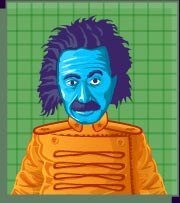The All-or-None Law and How the Nervous System Codes Stimulus Intensity
 “Axonal transmission
of information acts according to the all-or-none law, which simply means that if the stimulus
causes enough depolarization for the threshold of excitation to be reached, then the neuron generates an action potential
all the way from the axon hillock to the axon terminals.
Each action potential moves at a constant rate of
speed and has a constant size for a given neuron.
If the threshold is not reached, then the resting
potential is reestablished and the information is not relayed.
It’s all or nothing, you see.
Hopefully, this reminds you of our fuse that we discussed
earlier: It either burns or it doesn’t.
The neuron acts the same way: It either reacts, or
it doesn’t.
“Axonal transmission
of information acts according to the all-or-none law, which simply means that if the stimulus
causes enough depolarization for the threshold of excitation to be reached, then the neuron generates an action potential
all the way from the axon hillock to the axon terminals.
Each action potential moves at a constant rate of
speed and has a constant size for a given neuron.
If the threshold is not reached, then the resting
potential is reestablished and the information is not relayed.
It’s all or nothing, you see.
Hopefully, this reminds you of our fuse that we discussed
earlier: It either burns or it doesn’t.
The neuron acts the same way: It either reacts, or
it doesn’t.
“It is important to understand the size
and speed of the nerve impulse are independent of the intensity of the stimulus.
As long as the stimulus is sufficient for the neuron’s
threshold to be reached, the neuron produces an action potential; a more intense stimulus won’t make the action potentials
any larger or move any faster: It doesn’t matter if we use a match or a laser to ignite our fuse.
If it is hot enough to ignite, it burns.
Same with the neuron.
“That brings us to the obvious question:
How do you tell the difference between a mild stimulus and one that’s more intense?
What mechanisms does the nervous system use to
code the intensity of a stimulus?”
The student sitting next to you raises
her hand.
“What do you mean by differences in stimulus
intensity?”
she asks.
“Can you give us an example?”
Mindstein replies: “Sure.
Say you’re out at the beach and your Volarian
octo-hound comes by and sees your little pinkie toe wiggling and catches it in his teeth.
He doesn’t bite your toe, just puts his
teeth on it.
That’s an example of a mild stimulus.
“Now, a little later you’re
dozing, and a moon crab comes scuttling by, sees your pinkie toe wiggling, and grabs it with its claw.
That’s the more intense stimulus.
Obviously, you can tell the difference between
the two stimuli.
The question is: How does your nervous system
signal the difference to you?”
 “Axonal transmission
of information acts according to the all-or-none law, which simply means that if the stimulus
causes enough depolarization for the threshold of excitation to be reached, then the neuron generates an action potential
all the way from the axon hillock to the axon terminals.
Each action potential moves at a constant rate of
speed and has a constant size for a given neuron.
If the threshold is not reached, then the resting
potential is reestablished and the information is not relayed.
It’s all or nothing, you see.
Hopefully, this reminds you of our fuse that we discussed
earlier: It either burns or it doesn’t.
The neuron acts the same way: It either reacts, or
it doesn’t.
“Axonal transmission
of information acts according to the all-or-none law, which simply means that if the stimulus
causes enough depolarization for the threshold of excitation to be reached, then the neuron generates an action potential
all the way from the axon hillock to the axon terminals.
Each action potential moves at a constant rate of
speed and has a constant size for a given neuron.
If the threshold is not reached, then the resting
potential is reestablished and the information is not relayed.
It’s all or nothing, you see.
Hopefully, this reminds you of our fuse that we discussed
earlier: It either burns or it doesn’t.
The neuron acts the same way: It either reacts, or
it doesn’t.